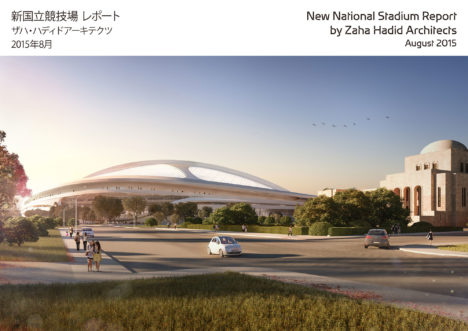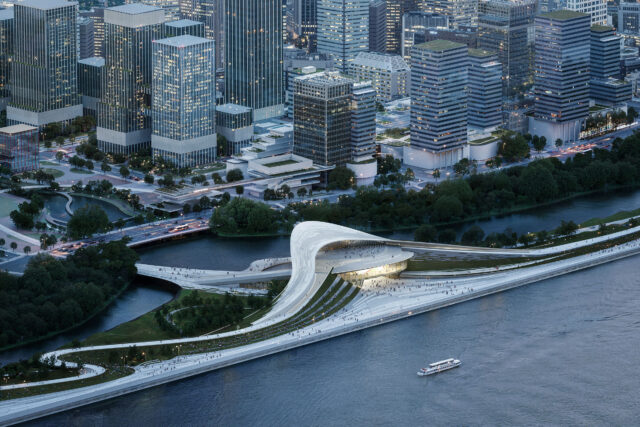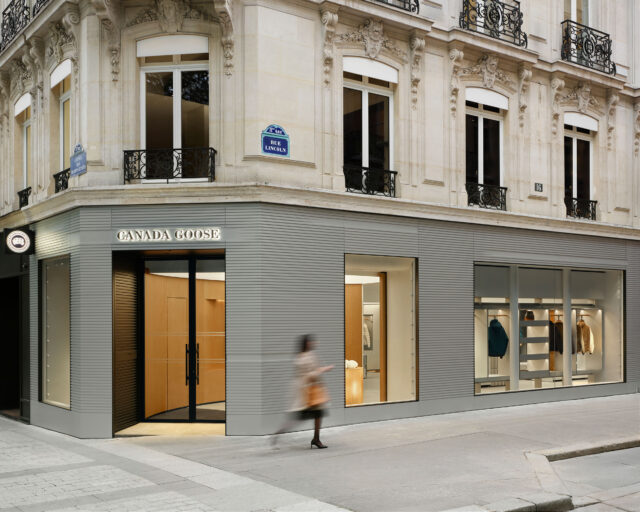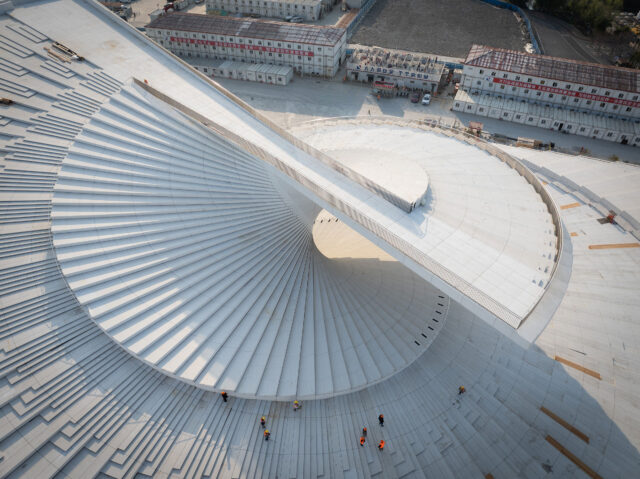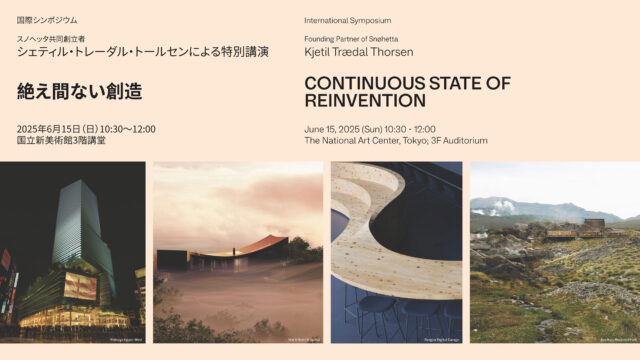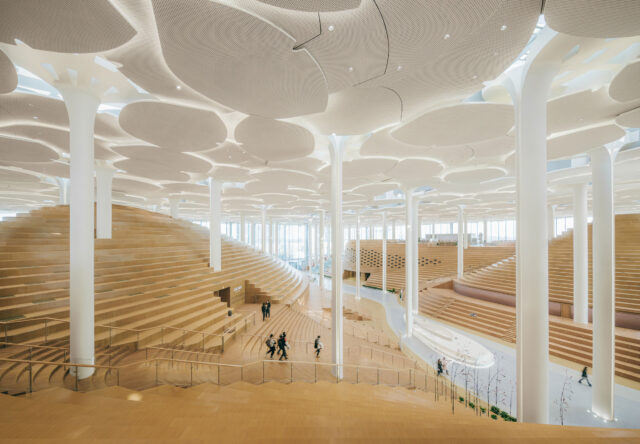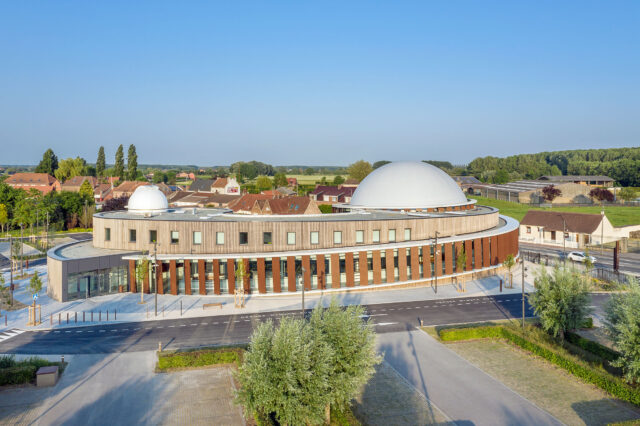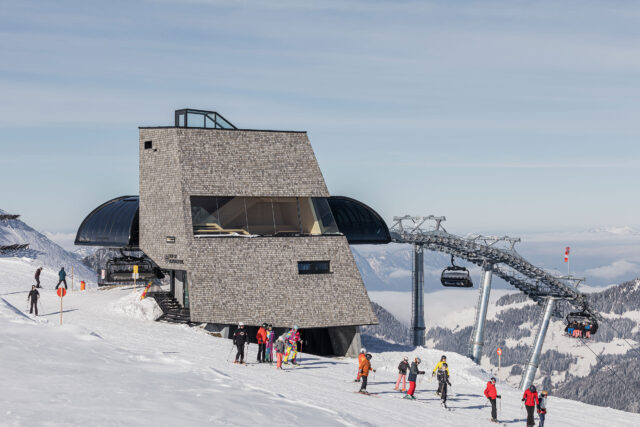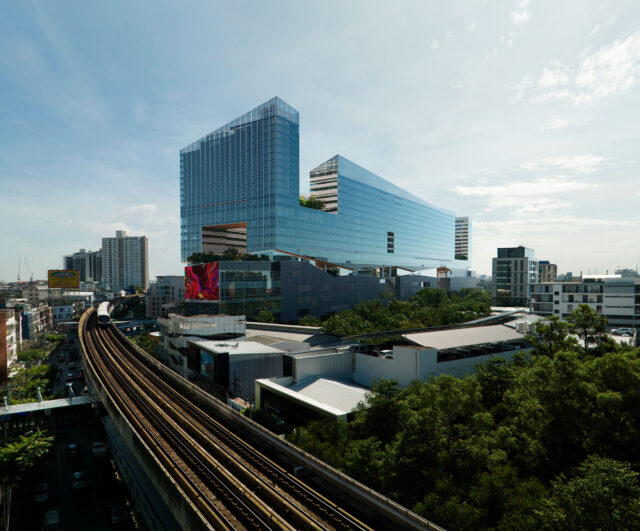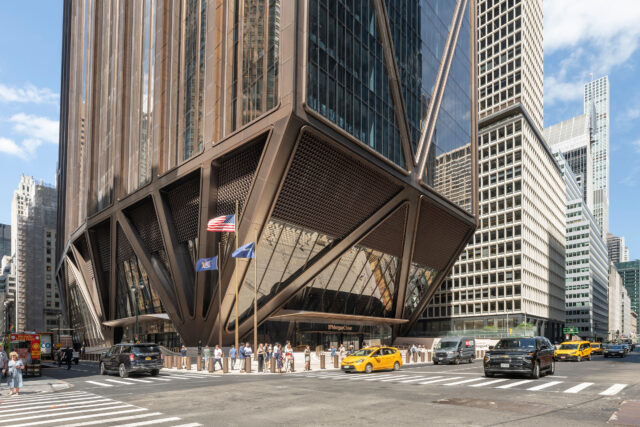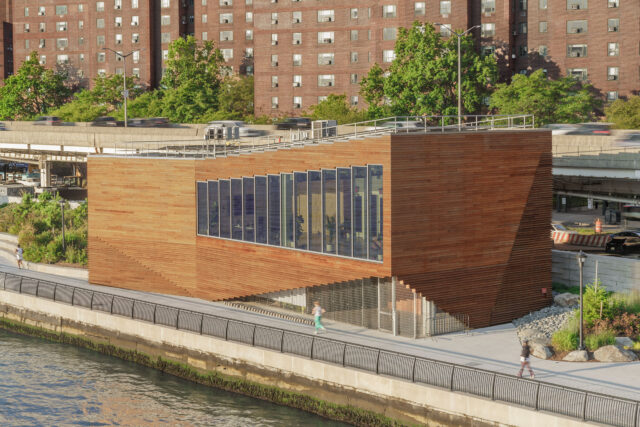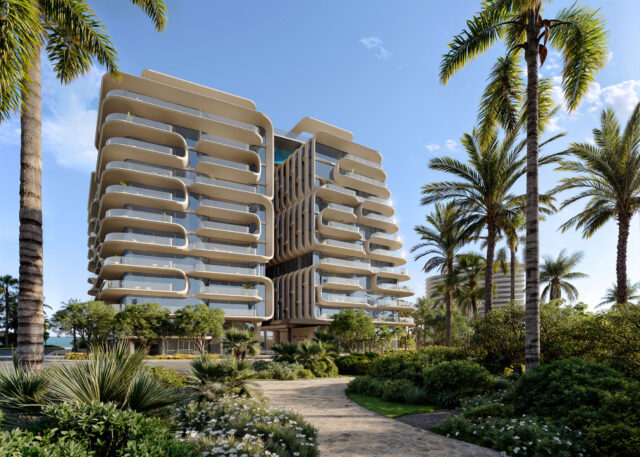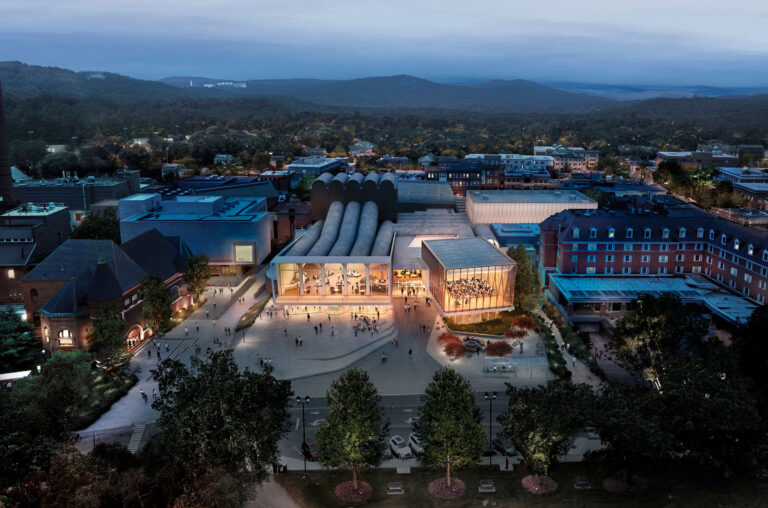
SHARE スノヘッタによる、アメリカ・ニューハンプシャー州の、ホプキンス芸術センターの改修と拡張。大学敷地内の地域の舞台芸術と映画の拠点施設で、構内の表玄関として人々の集う場となるべく都市構造や近隣の自然を参照し計画、既存建築を補完しながら現代的な表現創造の場をつくる



スノヘッタによる、アメリカ・ニューハンプシャー州の、ホプキンス芸術センターの改修と拡張。大学敷地内の地域の舞台芸術と映画の拠点施設で、構内の表玄関として人々の集う場となるべく都市構造や近隣の自然を参照し計画、既存建築を補完しながら現代的な表現創造の場をつくる計画です。
こちらはリリーステキストの翻訳
ダートマス大学とスノヘッタが、ホプキンス芸術センターの改修・拡張工事の完成予想図を発表
既存のアートセンターの拡張と近代化により、21世紀の舞台芸術の創造とコラボレーションをサポートします。
ダートマス大学とスネヘッタは、ホプキンス芸術センター(ホップ)の拡張と再設計に関する最初のレンダリングを公開しました。このプロジェクトは、キャンパス内のアート地区への新たなゲートウェイとなるものです。アーティストと観客を結びつけるために設計され、若返り、近代化されたホップは、新しい練習とパフォーマンススペースを提供し、周辺の芸術施設との接続を強化し、プロジェクト全体を通してアクセス性と移動性を向上させることにより、画期的で学際的な創造性の歴史的遺産を構築する予定です。この拡張により、アーティストや観客は、ウォレス・K・ハリソンによるホップのオリジナル建築を補完しながら、現代的な表現を創造し、楽しむことができるようになるのです。スノヘッタの拡張工事は、遊び心にあふれた表現力豊かな既存の建築物とともに、建物の象徴であるアーチやザ・グリーンでの存在感、トップ・オブ・ザ・ホップ、ムーア劇場、スポルディング講堂などの愛される空間を維持しながらも、機能しているのです。
迎え、集い、創る
ホップは、キャンパスの中心にあるザ・グリーンとハノーバーの街をつなぐ多面的な芸術文化地区を紹介し、キャンパスの表玄関として、また、訪問者やスタッフ、学生が集う重要な場所として機能します。ホップを歓迎するため、デザインはキャンパスに隣接する道路や周辺のニューイングランドの田舎町の都市構造に手を伸ばし、近くの山や自然の生態系からインスピレーションを得て、そのユニークな天才的位置づけを称えることにしています。ダートマスを訪れる人々、ダートマスの学生、ハノーバーの人々の体験はすべて、この地域の地形と、洗練された芝生、堂々とした建物、優れた芸術活動を行うキャンパスを印象的に引き立てる、荒々しい自然の美しさによって形作られているのです。この荒々しいものと洗練されたものとの組み合わせが、私たちのデザインに反映されています。20世紀半ばに建てられた建物の優雅な曲線からインスピレーションを得た外部広場は、集い、出会い、入るための場所へと訪問者を導く直感的な動きをするように造形されています。学生や教員の日常生活をより豊かにするプラットフォームとしてデザインされたこの広場は、訪れる人々を歓迎し、建物の中で起きている芸術活動のダイナミズムを垣間見ることができます。
この広場は、ホップ内に広がる新しい入口につながり、既存の建物スペースと創造的なプロセスを豊かにするための新しい施設をつなぐ中心的な出会いの場となります。フォーラムと名付けられた新しいロビーは、学生や教職員と一日中、そして公演の前後にも観客と一緒に活動する活気ある社交場となる予定です。中央の階段はフォーラムと2階を結び、新しいリサイタルホールとパフォーマンスラボという革新的でインタラクティブなパフォーマンスイベントのための2つの会場と、1階と広場を結んでいます。150席のリサイタルホールは、広場を見下ろすガラス張りのランタンとして設計され、ザ・グリーンのシュガー・メープルを眺めながらベーカー・ライブラリー・タワーの素晴らしい景色を眺めることができます。先細りのアーチ型フレームの窓は、革新的な曲線のマリオンシステムを用いて作られており、ホールのフレキシブルな座席構成に十分な採光を可能にしています。特注の仕上げと洗練されたディテールが施されたこのスペースには、最先端のオーディオビジュアル機器が設置され、学生主導のパフォーマンスメディアの制作を促進するとともに、ホップをデジタルパフォーマンスのための放送センターとして生まれ変わらせることができます。
フォーラムの1階下にある新しいダンススタジオは、一部が沈められたリハーサルスペースで、北向きの明かり取り窓から自然光が入り、広場の樹冠がちらりと見えるようになっています。ホップ初のダンスリハーサルスペースとして、24フィート(※約7m)の天井高と明るい室内空間は、ダンスグループにとって理想的な場所となります。また、ホップの900人収容の劇場であるスポルディング・オーディトリアムは改装され、集いの場として親しまれてきたトップ・オブ・ザ・ホップは細心の注意を払って改修されました。シアターリハーサルラボなど、ホップの下層階にあるいくつかのスペースは、このプロジェクトの一環として再構成され、再設計される予定です。
スネヘッタの設立パートナーであるクレイグ・ダイカーズは言います。
「アンサンブルの声、ダンスビデオの制作チーム、そして観客自身、すべてが多様な参加による創造的な可能性を表しています」
「私たちは、新しい形の芸術的コラボレーションと創造的表現の場として、ホップの先駆的な遺産を拡張し、新しいリハーサルと制作スペースを建物にもたらすことで、多様な視点と制作方法のサポートを継続できることを嬉しく思っています」
スノヘッタのホップ拡張は、ダートマス芸術地区の最新の改善となり、マチャド・シルベッティが2012年に完成させたブラック・ファミリー視覚芸術センターと、2019年にトッド・ウィリアムスとビリー・ツィアン・アーキテクツが再デザインしたフード美術館の改装に続いて行われます。2022年末に着工し、2025年に生まれ変わった新しいホップが再オープンする予定です。建設期間中も、ホップはダートマス大学キャンパス内外のスペースを利用して、さまざまな対面式パフォーマンスやプログラムを提供する予定です。
ホップの拡張と近代化は、公共空間、パフォーマンス施設、観客の間のダイナミックな相互作用として学際的な芸術コラボレーションを想定しているスノヘッタが設計した最新の舞台芸術施設です。
ホプキンスセンターについて
ダートマス大学の緑地に位置するホプキンス芸術センターは、キャンパスとニューイングランド地方の舞台芸術と映画の拠点としての役割を担っています。体験型教育のリーダーとして、客員アーティスト、レジデントアーティスト、学生アンサンブル、学術部門を集め、多様な声や視点を表現し、幅広い芸術形式やアイデアに関わる作品を制作・発表することに力を注いでいます。創造的な実験のための実験室として、また、さまざまな芸術分野、ダートマスのカリキュラム、より広いコミュニティ間のつながりを探求するための推進役として機能しています。
ダートマス大学について
1769年に設立されたダートマス大学は、アイビーリーグの一員であり、常に世界最高の学術機関のひとつに数えられています。ダートマス大学は、優れたリベラルアーツ学部および大学院教育への深い関与と、芸術・科学および4つの主要大学院(ガイゼル医学部、グアリーニ大学院・高等研究院、セイヤー工学部、タック経営大学院)における優れた研究・学問を結びつけるという、独自のアイデンティティを確立しています。
以下の写真はクリックで拡大します





以下、建築家によるテキストです。
Renderings for Reimagined & Expanded Hopkins Center for the Arts Unveiled by Dartmouth and Snøhetta
Expansion and Modernization of Existing Arts Center Will Support 21st-century Performing Arts Creation and Collaboration
Dartmouth and Snøhetta have revealed the first renderings for the forthcoming expansion and redesign of the Hopkins Center for the Arts (the Hop), a project that will create a renewed gateway to the campus’s thriving Arts District. Designed to bring together artists and audiences, the rejuvenated and modernized Hop will build on a historic legacy of groundbreaking, interdisciplinary creativity by providing new practice and performance spaces, increased connections to surrounding arts buildings, as well as upgraded accessibility and mobility throughout the project. Along with state-of-the-art digital and broadcasting capabilities, the potential for interactive audience experiences, and increased rehearsal and production areas, the expansion will allow artists and audiences alike to create and enjoy contemporary forms of expression while complementing the Hop’s original architecture by Wallace K. Harrison. Snøhetta’s expansion works alongside the playfully expressive existing architecture while also preserving the building’s iconic arches and presence on The Green, as well as its beloved spaces like the Top of the Hop, Moore Theatre, and Spaulding Auditorium.
Welcome, gather, create
The Hop introduces visitors to a multifaceted arts and culture district that connects The Green at the center of campus with the town of Hanover, serving as a front door to the campus as well as a vital place of gathering for visitors, staff, and students. To extend The Hop’s welcome, the design reaches out to the adjacent streets of the campus and its surrounding New England small-town urban fabric, drawing inspiration from nearby mountains and native ecologies to celebrate its unique genius loci. The experiences of visitors, Dartmouth students, and the people of Hanover are all shaped by the region’s geography, and by its rugged natural beauty, which serves as a striking foil to the refined lawns, stately buildings, and accomplished arts practices of the campus. This combination of the rugged and refined is reflected in our design. The exterior plaza, taking inspiration from the gracious curves of the mid-twentieth century building, is sculpted for intuitive movement to guide visitors towards places for gathering, meeting, and entering. Designed as a platform to elevate the daily lives of students and faculty, the plaza welcomes visitors and offers a glimpse into the dynamism of the arts processes happening inside the building.
The plaza connects visitors to a new entry that expands inside the Hop to create a central meeting place linking the existing building spaces with new facilities dedicated to enriching the creative process. The new lobby, dubbed the forum, creates a vibrant social space that will be active with students, faculty, and staff throughout the day, and with audiences before and after performances. A central stair links the forum with the second-floor, connecting the new Recital Hall and a Performance Lab, two venues designed for innovative and interactive performance events, with the ground floor and plaza. The 150-seat Recital Hall is designed as a glass-enclosed lantern that overlooks the plaza and offers stunning views of the Baker Library Tower while looking into the Sugar Maples on The Green. Its tapered arch-framed windows are created using an innovative, curved mullion system, allowing for ample daylighting of the flexible seating configurations in the Hall. The space, outfitted with bespoke finishes and refined details, also offers state-of-the-art audio-visual equipment that will facilitate the creation of student-led performance media while transforming the Hop into a broadcasting center for digital performances.
A level below the forum sits the new Dance Studio, a partially-submerged rehearsal space with north-facing clerestory windows bringing in natural light and glimpses to the plaza tree canopy. As the Hop’s first purpose-built dance rehearsal space, the Studio’s 24-foot ceiling heights and well-lit interiors will offer the ideal place for dance troupes to perfect their routines. Our design also refurbishes the Hop’s 900-seat theatre, Spaulding Auditorium, while meticulously upgrading the Top of the Hop, a beloved gathering space. Several spaces on the lower level of the Hop, including the Theater Rehearsal Lab, will be reconfigured and redesigned as part of the project.
Craig Dykers, Snøhetta Founding Partner said, “The voices of an ensemble, the production team for a dance video, and audiences themselves all represent the creative potential of diverse participation. We are excited to expand the Hop’s pioneering legacy as a venue for emerging forms of artistic collaboration and creative expression by bringing new rehearsal and production spaces to the building, ensuring continued support for a variety of perspectives and ways of making.”
Snøhetta’s expansion of the Hop represents the latest improvement to the Dartmouth Arts District and follows the creation of the Black Family Visual Arts Center, completed in 2012 by Machado Silvetti, and the renovation of the Hood Museum of Art, redesigned by Tod Williams and Billie Tsien Architects in 2019. Construction is scheduled to begin in late 2022, and the new, transformed Hop will reopen in 2025. During the construction process, the Hop will continue to offer a range of in-person performances and programs utilizing spaces throughout the Dartmouth campus and beyond.
The expansion and modernization of the Hop is the latest performing arts venue designed by Snøhetta that envisions interdisciplinary arts collaborations as dynamic interactions between public space, performance facilities, and audiences. These projects include the Norwegian National Opera and Ballet (2008), the Wolfe Center for the Collaborative Arts at Bowling Green State University (2011), the Isabel Bader Centre for the Performing Arts at Queen’s University (2014), the Moss Arts Center at Virginia Tech (2014), and the St. Louis Symphony Orchestra Powell Hall Expansion (2025).
About the Hopkins Center for the Arts
Situated on the Green at Dartmouth, the Hopkins Center serves as a hub of performing arts and film for the campus and New England region. A leader in experiential education, it is dedicated to bringing together visiting artists, resident artists, student ensembles, and academic departments to produce and present work that represents diverse voices and perspectives and engages with a wide spectrum of artistic forms and ideas. It acts as a laboratory for creative experimentation and an instigator for exploring the connections among different artistic disciplines, the Dartmouth curriculum, and the wider community.
About Dartmouth
Founded in 1769, Dartmouth is a member of the Ivy League and consistently ranks among the world’s greatest academic institutions. Dartmouth has forged a singular identity for combining its deep commitment to outstanding undergraduate liberal arts and graduate education with distinguished research and scholarship in the Arts and Sciences and its four leading graduate schools—the Geisel School of Medicine, the Guarini School of Graduate and Advanced Studies, Thayer School of Engineering, and the Tuck School of Business.

